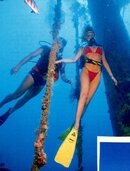David Wilson
Contributor
Thanks again for acknowledging, RickI, the image is from the collection of clippings stored on the Skin Diving History site at
Skin Diving History
You're right to be sceptical about the reliability of the valves at the end of the mask snorkels in choppy waters. Snorkel masks remain in production to this very day, but after being a standard feature of most diving equipment manufacturers' catalogues in the 1950s, they fell out of favour in the 1960s as serious items of gear. In calm seas, though, they may still be an option for people who don't like a snorkel mouthpiece in their mouths.
As for the Rondines, They are indeed classics in their field, apparently designed by Luigi Ferraro for Cressi. Details here:
Rondine Fins | Luigi Ferraro
It's ironic that the other fin image on the page, an open-heel fin, branded as "Superga", which now makes a range of street footwear, was described as "later left behind because of poor efficiency". During the 1960s and 1970s, full-foot fins were regarded as the best choice by European divers. That's what I thought too. Then the 1980s came along and manufacturers insisted that the opposite was true. I chose to stick with my original choice, being a believer in "if it ain't broke, why fix it?"
The name "Rondine" is Italian for "swallow" and the outline of the bird appears on the fins. Here's a picture of the prototype:

Cressi has made a positive gesture towards vintage divers by continuing to manufacture its cult rubber-skirted mask, the "Pinocchio", first produced in the early 1950s:

I wish the Italian company had maintained production of its all-rubber Cressi Rondine Extra fins, however, to complement the mask:

Modern Rondine fins might look like the originals, but the material they're made from, thermoplastic elastomers, mean they don't feel or act like their predecessors. Oceanways Aquapros, which continue to be made from natural rubber, are probably the closest we can get to the 1960s and 1970s Cressi originals:

Skin Diving History
You're right to be sceptical about the reliability of the valves at the end of the mask snorkels in choppy waters. Snorkel masks remain in production to this very day, but after being a standard feature of most diving equipment manufacturers' catalogues in the 1950s, they fell out of favour in the 1960s as serious items of gear. In calm seas, though, they may still be an option for people who don't like a snorkel mouthpiece in their mouths.
As for the Rondines, They are indeed classics in their field, apparently designed by Luigi Ferraro for Cressi. Details here:
Rondine Fins | Luigi Ferraro
It's ironic that the other fin image on the page, an open-heel fin, branded as "Superga", which now makes a range of street footwear, was described as "later left behind because of poor efficiency". During the 1960s and 1970s, full-foot fins were regarded as the best choice by European divers. That's what I thought too. Then the 1980s came along and manufacturers insisted that the opposite was true. I chose to stick with my original choice, being a believer in "if it ain't broke, why fix it?"
The name "Rondine" is Italian for "swallow" and the outline of the bird appears on the fins. Here's a picture of the prototype:

Cressi has made a positive gesture towards vintage divers by continuing to manufacture its cult rubber-skirted mask, the "Pinocchio", first produced in the early 1950s:

I wish the Italian company had maintained production of its all-rubber Cressi Rondine Extra fins, however, to complement the mask:

Modern Rondine fins might look like the originals, but the material they're made from, thermoplastic elastomers, mean they don't feel or act like their predecessors. Oceanways Aquapros, which continue to be made from natural rubber, are probably the closest we can get to the 1960s and 1970s Cressi originals:










